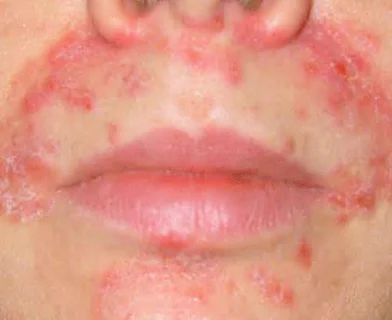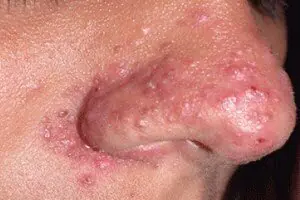Related and recommended questions
38 replies





This is perioral dermatitis!
How long have you been using hydrocortisone?
What else is on the skin and for how long?
Do you tolerate medications well?
How old are you?

This is perioral dermatitis.
Hydrocortisone, sinaflan and other hormonal drugs on the face are strictly prohibited! .
This is a vicious circle: if you apply it, it gets better, if you stop, it gets worse!
Not breastfeeding?
If not, then use:
Tab. "Unidox Solutab" - half a tablet * 1 time per day for up to 20 days.
Do not drink alcohol, milk or sunbathe!
Rosamet cream - apply a thin layer to problem areas every morning for up to 1-2 months.
Erythromycin ointment - apply a thin layer to problem areas every evening for up to 1 month.
Wash your face with boiled water!
Unsubscribe after 20 days with a photo or earlier if necessary!





Hello !
This is perioral dermatitis.
Pimafucort is contraindicated.
Use:
- Erythromycin ointment - apply a thin layer to the rash every evening for up to 1 month.
— Rosamet cream — apply a thin layer on the rash every morning for up to 1 month.


Site search
What should I do if I have a similar but different question?
If you did not find the information you need among the answers to this question, or your problem is slightly different from the one presented, try asking an additional question to the doctor on the same page, if it is on the topic of the main question. You can also ask a new question, and after a while our doctors will answer it. It's free. You can also search for the information you need in similar questions on this page or through the site search page. We will be very grateful if you recommend us to your friends on social networks.
Medical portal 03online.com provides medical consultations via correspondence with doctors on the website. Here you get answers from real practitioners in your field. Currently, on the site you can get advice in 48 areas: allergist, anesthesiologist-resuscitator, venereologist, gastroenterologist, hematologist, geneticist, gynecologist, homeopath, dermatologist, pediatric gynecologist, pediatric neurologist, pediatric urologist, pediatric surgeon, pediatric endocrinologist, nutritionist, immunologist a , infectious disease specialist, cardiologist, cosmetologist, speech therapist, ENT specialist, mammologist, medical lawyer, narcologist, neurologist, neurosurgeon, nephrologist, oncologist, oncourologist, orthopedist-traumatologist, ophthalmologist, pediatrician, plastic surgeon, proctologist, psychiatrist, psychologist, pulmonologist, rheumatologist, radiologist , sexologist-andrologist, dentist, urologist, pharmacist, herbalist, phlebologist, surgeon, endocrinologist.
We answer 96.3% of questions.

Have you noticed a pimple on your nose and are trying to find out the reason for its appearance? The causes of pimples around the nose can be the most unexpected, but most often their appearance is associated with a malfunction of your sebaceous glands. Their job is to create a natural protective film called sebum. If the clot gets larger, it clogs the pores and ducts through which the subcutaneous oil cannot escape. fat, which causes acne to appear on the skin.
If such pores still have an opening, then blackheads are formed. If sebum gets into the canal, a cyst appears, which is also called a comedon. If the inflammatory process begins, red large pimples appear, which are known as the inflamed form of acne around the nose.
Pimples around the nose: causes
Experts, usually answering the question “what causes acne around the nose?”, also add that acne can appear not only in young people. Older and middle-aged people are also familiar with acne on the body and face, including the area around the nose.
In teenagers, the causes of acne are most often associated with hormonal surges during puberty. When adults have acne under the nose, on the nose or elsewhere, it is likely a symptom of a circulatory, endocrine or immune system disease, or an infectious disease. It is believed that even one pimple on the tip of the nose is the first sign of heart, stomach or liver problems.
Possible causes of acne around the nose include stress, lack of vitamin A, hormonal imbalances in the body and the use of poor cosmetics. The appearance of acne around the nose cannot be considered as a separate subject of skin disorder and the cause of acne, since the causes of their appearance are closely related to other general reasons for the appearance of acne on the face and the whole body in particular. But if you have a large pimple in the area around the nose, then its appearance can be considered as a separate subject and a problem of this particular part of the skin of the face, as in our case, the area around the nose.
White, small, red pimples around the nose
In most cases, these types of acne can be found around the nose:
- Itchy small pimples Their usual place of appearance is around the nose and mouth. Doctors believe that this is a sign of an acute condition of herpes.
- White Pimples They resemble white dense nodules If you have white pimples, the easiest way to remove a pimple on your nose is with electrocoagulation.
- Red pimples are the result of an inflamed cyst. These acne are painful and several pimples can cluster together to form bumps on the nose.
- Pustular white pimples may appear as a result of staph infections of red pimples. The appearance of pus pimples can be very painful, so you need to start treating these pimples around the nose as soon as you notice the first signs of their appearance.
- Pink acne The reason for their appearance is the affect of the appearance of Demodex mites under the skin of your nose. Such acne on the nose appears simultaneously with gastrointestinal disorders. Under the influence of pink acne, your skin becomes rough, thickened and covered with tubercles.
Diagnosis of the causes of acne around the nose
Diagnosing and identifying the exact cause of pimples around the nose can only be done by a specialist after you have undergone a serious examination. If you notice any worrying pimples around the nose, then consult a doctor immediately, as skin blemishes are not just small things. If you notice that pimples appear not only on the surface but also inside your nose, and their appearance recurs on a regular basis, be very careful. It's time to seek help from a clinic and consult a dermatologist.
As a rule, the patient is prescribed a complex treatment: a ten-day course of treatment with metronidazole, both in tablets and in the form of an ointment for external treatment of problem areas. In more complex cases, doctors prescribe antibiotics: taking Acyclovir and using external clindamycin. In addition, it is recommended to be sure to take vitamins appropriate for your age and needs. In addition, you should also completely stop smoking and drinking alcohol.
There are some undesirable actions that you could try before you see a doctor Never squeeze pimples Avoid squeezing pimples Such actions can cause the subcutaneous pimple on the nose to release pus onto the skin or even into the bloodstream, which is much worse And this will be followed by repeated infection, and the pimples will not only multiply on the nose, but will also take on a more inflamed appearance on the face in the future.
How to get rid of acne around the nose
Benzoyl peroxide
Benzoyl peroxide may dry out the skin or cause burning and redness at the site of application. Use it only as directed by a doctor.
Consult a dermatologist
Try these treatments for acne around your nose at home for at least three to four weeks. If your skin condition and the number of pimples around your nose do not improve, make an appointment with your dermatologist. If you have moderate to severe acne, see a dermatologist before trying any of these methods in order to receive professional recommendation and advice on their treatment in your case of illness.
Without this professional advice, you could be causing more problems than you think. Your dermatologist may recommend other approaches to treating acne around the nose.
A dermatologist may recommend prescription medications or alternative treatments such as microdermabrasion, chemical peels, or light laser treatments. They can also help remove pimples immediately using a special tool called a comedone extractor.
Salicylic acid
Salicylic acid can also cause skin irritation and burning if used incorrectly. It should be used only for its intended purpose.
Wash your face daily morning and evening
To help prevent acne around the nose and the rest of the face, wash your face regularly every day, twice a day. You should also cleanse your face after any sweaty or physical activity. Large amounts of sweat can increase the incidence of acne.
Gently wash your face, applying cleanser in gentle circular motions. Do not wash your face too much. More than twice a day is not recommended.
Use makeup that doesn't cause acne
Some cosmetics can irritate the skin and cause acne. If you have problems with acne on your nose, consider going makeup-free or wearing as little makeup as possible. When choosing foundations, look for oil-free and non-homogeneous makeup bases that won't clog your nose. pores.
Chemicals and oils in makeup, even when using hypoallergenic products, can clog your pores and cause breakouts.
Always remove all makeup before bed
This helps reduce clogged pores.
Use a sea salt mask for acne
You can also dry out pimples on your nose using sea salt.
- Take one teaspoon of sea salt and stir it into three teaspoons of hot water.
- Stir to dissolve the sea salt.
- If you don't want to use the mask all over your face, take a Q-tip and dip the tip into your mixture and apply the solution where needed.
- Just make sure you avoid getting the mixture near your eyes.
- Leave the mixture for 10 minutes.
Don't leave it on for too long Sea salt draws out water and can dry out your skin too much.
Rinse your face completely with cool or warm water.
Pathological formation in the form of acne can appear on almost any part of the body. In this case, it does not matter at all what age category a person is in. The causes of rashes can be very diverse, which we propose to understand in our article.
What causes the appearance of acne on the nose?

On the face, and especially in the nose area, the pores, as a rule, are especially enlarged in most people, and the sebaceous glands are located on the surface of the skin. In most cases, acne near the nose appears in young people during adolescence, which is due to elementary puberty and a surge in hormones. Although cases have become more frequent when similar rashes are observed in older people.
Numerous medical studies are aimed at understanding the reasons why acne “pops up” on the face with a certain periodicity. It has been established that such rashes may indicate:
- disruptions in the gastrointestinal tract;
- dysfunction of the secretion glands (internal);
- high level of release of male hormone (androgen);
- presence of problems with blood vessels;
- incorrectly selected cosmetics (creams, powders, etc.);
- individual sensitivity of the body, for example, to temperature changes;
- constant or episodic stress;
- vitamin deficiency;
- basic non-compliance with personal hygiene rules, as well as squeezing out old pimples, etc.
Of course, this is only a small part of the reasons that provoke the appearance of rashes on the face. There is no point in trying to figure out the nature of such neoplasms on the face on your own. It is better not to waste precious time and seek advice from a dermatologist, who will identify all the pitfalls and prescribe adequate therapy.
Types of acne
If you look in more detail, it turns out that acne can be very different. Each type of rash has its own nature of origin, which in turn requires different treatment methods.
- White pimples are completely painless pimples, which often appear due to excess sebum production. They can appear not only on the nose, but also around the eyes, on the cheeks and neck. It is useless to fight such rashes on your own. You can only introduce an infection, which will lead to even worse consequences. You should definitely visit a cosmetology office, where specialists, having chosen the right treatment method, will quickly clean the surface of the skin.
- Red - pimples, which are most likely complicated by infection (staphylococcus). On the nose, such rashes are especially painful, and if they still penetrate deeply into the skin, they can take a long time to mature. To get rid of this type of acne, you must fulfill a set of requirements:
- follow a diet, exclude sweet, salty, smoked foods;
- take vitamins;
- spend more time outdoors so that the sun and air have a positive effect on the epidermis;
- Treat acne areas with disinfectants as often as possible;
- visit the treatment room to perform the procedure for drying the abscesses.
- Pink pimples appear as a result of infection by iron mites. Self-medication in this case is simply categorically unacceptable. Contact a specialist immediately for professional help. To prevent the appearance of such acne, you just need to take care of your skin and clean problem areas in a timely manner.
- Black - appear as a result of the opening of pores and oxidation of sebum. Such spots cannot be washed off with ordinary water. At home, you can perform steam baths followed by applying a mask to the affected area. After steaming, removing the clogged plug will be easy.
Features of therapy
If you look at it, pimples near the nose are one of the types of dermatitis, which is categorically not recommended to be left without treatment. Moreover, squeezing even one small pimple can provoke the appearance of a whole “constellation”, which in turn causes a number of indignations in a person.
A comprehensive solution to a delicate problem will allow you to get rid of rashes in a short period of time. So, you need to follow fairly simple recommendations, namely:
- in the morning and before bed, the face is cleansed with a special tonic with a drying effect, or you can use a soft scrub;
- After cleansing, the rash area should be treated with an antiseptic cream or ointment prescribed by a dermatologist.
The most important requirement, or rule if you will, is that under no circumstances should you squeeze pimples around your nose. Regardless of whether this procedure was performed with clean hands or dirty hands, the rashes will not decrease. On the contrary, the infection will spread further, capturing a new area of skin.
It is also worth noting that depending on the size of the pimple, squeezing it may leave a scar on the skin. Moreover, any impact on the skin can lead to injury to the epidermis, which negatively affects its attractiveness and elasticity.



